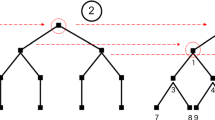Abstract
Two-stage stochastic programming problems with the probabilistic and quantile criteria in the general statement are considered. Sufficient conditions for the measurability of the loss function and also for the semicontinuity of the criterion functions are given. Sufficient conditions for the existence of optimal strategies are established. The equivalence of the a priori and a posteriori statements of the problems under study is proved. The application of the confidence method, which consists in the transition to a deterministic minimax problem, is described and justified. Sample approximations of the problems are constructed and also conditions under which the optimal strategies in the approximating problems converge to the optimal strategy in the original problem are presented. The results are illustrated by an example of the linear two-step problem. The two-stage problem with the probabilistic criterion is reduced to a mixed-integer problem.
Similar content being viewed by others
References
Birge, J.R. and Louveaux, F., Introduction to Stochastic Programming, New York: Springer, 2011.
Kall, P. and Mayer, J., Stochastic Linear Programming: Models, Theory and Computation, New York: Springer, 2011.
Pr´ekopa, A., Stochastic Programming, Boston: Kluwer, 1995.
Shapiro, A., Dentcheva, D., and Ruszczy´nski, A., Lectures on Stochastic Programming. Modeling and Theory, Philadelphia: SIAM, 2009.
Wets, R.J.-B., Stochastic Programs with Fixed Recourse: The Equivalent Deterministic Program, SIAM Rev., 1974, vol. 16, no. 3, pp. 309–339.
Frauendorfer, K., Stochastic Two-Stage Programming, Berlin—Heidelberg: Springer, 1992.
Kulkarni, A.A. and Shanbhag, U.V., Recourse-Based Stochastic Nonlinear Programming: Properties and Benders-SQP Algorithms, Comput. Optim. Appl., 2012, vol. 51, no. 1, pp. 77–123.
Kibzun, A.I. and Kan, Y.S., Stochastic Programming Problems with Probability and Quantile Functions, Chichester—New York—Brisbane—Toronto—Singapore: Wiley, 1996.
Kibzun, A.I. and Kan, Y.S., Zadachi stokhasticheskogo programmirovaniya s veroyatnostnymi kriteriyami (Stochastic Programming Problems with Probabilistic Criteria), Moscow: Fizmatlit, 2009.
Kibzun, A.I. and Naumov, A.V., A Two-Stage Quantile Linear Programming Problem, Autom. Remote Control, 1995, vol. 56, no. 1, part 1, pp. 68–76.
Schultz, R. and Tiedemann, S., Conditional Value-at-Risk in Stochastic Programs with Mixed-Integer Recourse, Math. Program., Ser. B, 2006, vol. 105, pp. 365–386.
Norkin, V.I., Kibzun, A.I., and Naumov, A.V., Reducing Two-Stage Probabilistic Optimization Problems with Discrete Distribution of Random Data to Mixed-Integer Programming Problems, Cybernet. Syst. Anal., 2014, vol. 50, no. 5, pp. 679–692.
Sen, S., Relaxation for Probabilistically Constrained Programs with Discrete Random Variables, Oper. Res. Lett., 1992, vol. 11, pp. 81–86.
Ruszczy´nski, A., Probabilistic Programming with Discrete Distributions and Precedence Constrained Knapsack Polyhedra, Math. Program., 2002, vol. 93, pp. 195–215.
Luedtke, J., Ahmed, S., and Nemhauser, G., An Interger Programming Approach for Linear Programs with Probabilistic Constraints, Math. Program., 2010, vol. 122, pp. 247–272.
Saxena, A., Goyal, V., and Lejeune, M.A., MIP Reformulations of the Probabilistic Set Covering Problem, Math. Program., 2010, vol. 121, pp. 1–31.
Bogdanov, A.B. and Naumov, A.V., Solution to a Two-step Logistics Problem in a Quantile Statement, Autom. Remote Control, 2006, vol. 67, no. 12, pp. 1893–1899.
Kibzun, A.I. and Tarasov, A.N., Stochastic Model of the Electric Power Purchase System on a Railway Segment, Autom. Remote Control, 2018, vol. 79, no. 3, pp. 425–438.
Artstein, Z. and Wets, R.J.-B., Consistency of Minimizers and the SLLN for Stochastic Programs, J. Convex Anal., 1996, vol. 2, pp. 1–17.
Pagnoncelli, B.K., Ahmed, S., and Shapiro, A., Sample Average ApproximationMethod for Chance Constrained Programming: Theory and Applications, J. Optim. Theory Appl., 2009, vol. 142, pp. 399–416.
Campi, M.C. and Garatti, S., A Sampling-and-Discarding Approach to Chance-Constrained Optimization: Feasibility and Optimality, J. Optim. Theory Appl., 2011, vol. 148, pp. 257–280.
Higle, J.L. and Sen, S., Statistical Approximations for Stochastic Linear Programming Problems, Ann. Oper. Res., 1999, vol. 85, pp. 173–192.
Ivanov, S.V. and Kibzun, A.I., On the Convergence of Sample Approximations for Stochastic Programming Problems with Probabilistic Criteria, Autom. Remote Control, 2018, vol. 79, no. 2, pp. 216–228.
Ioffe, A.D. and Tikhomirov, V.M., Theory of Extremal Problems, Amsterdam: North-Holland, 1979.
Rockafellar, R.T. and Wets, R.J.-B., Variational Analysis, Berlin: Springer, 2009.
Shiryaev, A.N., Probability-1, New York: Springer, 2016.
Zhenevskaya, I.D. and Naumov, A.V., The Decomposition Method for Two-Stage Stochastic Linear Programming Problems with Quantile Criterion, Autom. Remote Control, 2018, vol. 79, no. 2, pp. 229–240.
Kibzun, A.I., Comparison of Two Algorithms for Solving a Two-Stage Bilinear Stochastic Programming Problem with Quantile Criterion, Appl. Stochast. Models Business Industry, 2015, vol. 31, no. 6, pp. 862–874.
Ivanov, S.V. and Kibzun, A.I., Sample Average Approximation in a Two-Stage Stochastic Linear Program with Quantile Criterion, Proc. Steklov Inst. Math., 2018, vol. 303, no. 1, pp. 107–115.
Acknowledgments
This work was supported by the Russian Foundation for Basic Research, project no. 17-07-00203A.
Author information
Authors and Affiliations
Corresponding authors
Additional information
Russian Text © The Author(s), 2019, published in Avtomatika i Telemekhanika, 2019, No. 6, pp. 70–90.
Rights and permissions
About this article
Cite this article
Ivanov, S.V., Kibzun, A.I. General Properties of Two-Stage Stochastic Programming Problems with Probabilistic Criteria. Autom Remote Control 80, 1041–1057 (2019). https://doi.org/10.1134/S0005117919060043
Received:
Revised:
Accepted:
Published:
Issue Date:
DOI: https://doi.org/10.1134/S0005117919060043



